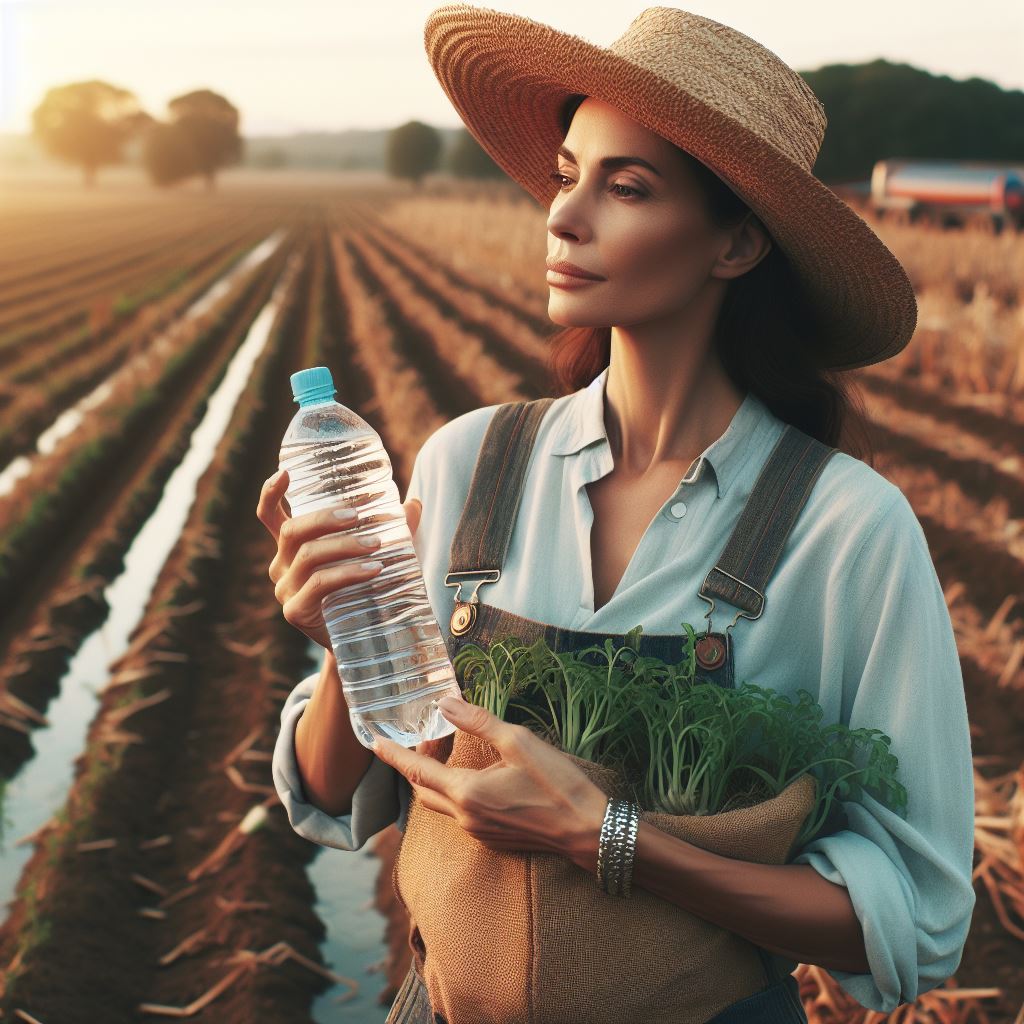Introduction
Drought-resistant crops are plants that can survive and produce in water-limited conditions.
These crops play a crucial role in ensuring food security, especially in areas prone to drought.
Benefits of drought-resistant crops for farmers
- Increased resilience: Farmers can rely on these crops to withstand water scarcity and maintain yields.
- Cost-effectiveness: Drought-resistant crops require less irrigation, reducing water and energy expenses for farmers.
- Enhanced profitability: By avoiding crop loss during droughts, farmers can secure their income and financial stability.
- Sustainability: The cultivation of drought-resistant crops helps conserve water resources and reduces environmental impact.
- Improved food security: By cultivating drought-resistant crops, farmers contribute to meeting food demands even in drought-prone regions.
- Adaptability: Drought-tolerant crops can diversify farming systems, allowing farmers to adapt to changing climate conditions.
Drought-resistant crops have become invaluable allies for farmers facing water scarcity challenges.
Their ability to withstand drought conditions provides farmers with resilience, cost-effectiveness, and increased profitability.
Moreover, cultivating these crops contributes to sustainability, food security, and adaptability in uncertain climatic conditions.
Types of drought-resistant crops
Crops with natural drought tolerance
- Native plants like sorghum and millets have developed natural mechanisms to withstand prolonged periods without water.
- These crops have evolved deep root systems that reach underground water sources.
- They also have waxy leaves to minimize water loss through transpiration.
- Other examples include teff, a grain native to Ethiopia, and amaranth, a leafy vegetable.
- These crops are well-suited for regions with limited access to irrigation or unreliable rainfall.
- They offer farmers a sustainable and cost-effective solution to combat droughts without relying on expensive technologies.
Genetically modified drought-resistant crops
- Scientists have developed genetically modified (GM) crops with enhanced drought tolerance.
- These crops are created by inserting specific genes that help them cope with water scarcity.
- GM crops can exhibit improved water-use efficiency and better stress tolerance.
- They are often designed to produce more efficient enzymes, allowing them to function optimally even in drought conditions.
- These crops offer potential benefits such as increased yields and reduced reliance on pesticides and fertilizers.
- However, the use of GM crops is not without controversies.
- Critics argue that the long-term environmental and health effects of genetically modified organisms (GMOs) are still uncertain.
- There are concerns about the potential for gene flow to wild or non-GM crops, leading to unintended consequences.
- Additionally, the patenting and control of GM crop technologies by a few agricultural corporations raise issues of accessibility and equity.
In fact, drought-resistant crops play a crucial role in ensuring food security and resilience in the face of climate change.
Crops with natural drought tolerance provide sustainable solutions for farmers in water-scarce regions, while genetically modified drought-resistant crops offer the potential for increased productivity.
However, it is important to carefully consider the potential risks and benefits of genetically modified crops to ensure the long-term sustainability and equitable access to these technologies.
By embracing a diverse range of drought-resilient crops, farmers can enhance their ability to withstand and mitigate the effects of droughts, ultimately ensuring a more resilient and food-secure future for all.
Read: Climate Impact: Soil Salinity and Solutions
Benefits of drought-resistant crops for farmers
Increased crop yield and productivity
Drought-resistant crops have the potential to significantly increase crop yield and productivity.
These crops are genetically modified to withstand harsh climatic conditions, including prolonged periods of drought.
By developing deeper and more robust root systems, these crops can access water and nutrients from deeper soil layers.
As a result, they are able to maintain growth and development even during periods of limited water availability.
This enables farmers to produce higher yields and increase their overall productivity.
Enhanced water-use efficiency
Drought-resistant crops are engineered to use water more efficiently, ensuring minimal water loss.
They have the ability to regulate their stomatal openings, which helps to conserve water during periods of drought.
This enhanced water-use efficiency enables farmers to maximize their irrigation practices and reduce water wastage.
By utilizing water more efficiently, farmers can allocate their limited water resources effectively and sustainably.
This helps in maintaining crop growth and minimizing the impact of drought on their farms.
Reduced dependence on irrigation
Drought-resistant crops require less water compared to traditional crops, reducing the dependency on irrigation.
Transform Your Agribusiness
Unlock your farm's potential with expert advice tailored to your needs. Get actionable steps that drive real results.
Get StartedWhile traditional crops demand regular irrigation to maintain their growth and prevent yield loss during droughts, this is not the case for drought-resistant crops.
These crops can survive with limited water availability and exhibit a higher tolerance to drought stress.
Farmers can rely more on natural precipitation and reduce the need for constant irrigation, minimizing costs and labor.
This can have significant advantages in regions where access to water or irrigation infrastructure is limited.
Economic advantages for farmers
Drought-resistant crops offer economic advantages to farmers affected by drought conditions.
By increasing crop yields and productivity, farmers can generate higher profits and secure their livelihoods.
With enhanced water-use efficiency, farmers can save on irrigation costs, reducing their overall expenses.
Moreover, the reduced dependence on irrigation helps in conserving water resources, minimizing expenses on water sourcing.
Additionally, the resilience to drought stress ensures a more stable income for farmers, even in unfavorable climatic conditions.
Overall, drought-resistant crops provide economic benefits, making farming more sustainable and profitable.
In general, drought-resistant crops offer numerous benefits to farmers, from increased crop yield and enhanced water-use efficiency to reduced reliance on irrigation and economic advantages.
By cultivating these crops, farmers can alleviate the impact of drought and ensure a more sustainable and prosperous agricultural future.
Read: Heatwaves and Hops: Brewing in a Hotter World
Techniques to promote drought resilience in crops
Drought resilience in crops can be achieved through various techniques that focus on effective water management, soil health, and disease control.
Implementing these practices is crucial to overcome the challenges posed by water scarcity and changing climatic conditions.
Soil management practices
Soil management practices play a fundamental role in promoting drought resilience.
Conservation tillage, the practice of leaving crop residues on the soil surface, helps retain moisture and improve organic matter content, enhancing the soil’s water-holding capacity.
Mulching, another effective technique, acts as a protective barrier, reducing evaporation and maintaining soil moisture levels.
Additionally, cover cropping improves soil structure, increases infiltration rates, and controls erosion, all contributing to increased drought tolerance.
Efficient irrigation methods
Adopting efficient irrigation methods is vital to conserve water and promote crop resilience in drought-prone areas.
Drip irrigation, an irrigation technique that delivers water directly to the roots through a network of tubes, minimizes water wastage by reducing evaporation and runoff.
Precision irrigation technologies, such as soil moisture sensors and computerized irrigation systems, enable farmers to provide water based on crop requirements, preventing over or under-watering.
Pest and disease management
Pest and disease management strategies are crucial for maintaining crop health, especially during periods of water scarcity.
Integrated pest management (IPM) involves the use of environmentally friendly practices, such as crop rotation, natural predators, and biological controls, to manage pests effectively.
By reducing reliance on chemical pesticides, farmers can protect beneficial organisms and maintain a balanced ecosystem.
Additionally, cultivating disease-resistant crop varieties enhances crop resilience, as these plants have built-in mechanisms to resist or tolerate diseases, reducing yield losses during drought conditions.
By implementing these techniques, farmers can mitigate the negative impacts of drought on crop yields and ensure food security.
However, it is essential to remember that there is no one-size-fits-all approach, as the effectiveness of each technique depends on factors such as soil type, climate, and crop type.
Therefore, farmers should tailor their practices to suit their specific conditions and seek guidance from agricultural experts and researchers.
In a nutshell, promoting drought resilience in crops requires a multi-faceted approach that includes efficient water management, soil conservation, and disease control.
Adopting soil management practices like conservation tillage, mulching, and cover cropping helps retain moisture and enhance soil health.
Implementing efficient irrigation methods such as drip irrigation and precision technologies conserves water and prevents wastage.
Finally, integrating pest and disease management techniques, such as IPM and disease-resistant crop varieties, safeguards crop health and productivity.
By utilizing these techniques, farmers can adapt to changing climatic conditions and secure their livelihoods in the face of drought.
Read: Fertilization Strategies in a Hotter World

Delve into the Subject: Eco-Farming: US Policies Shaping the Future
Challenges and limitations of drought-resistant crops
Initial investment and research
- Developing drought-resistant crops requires significant initial investment in research and development.
- Extensive research is needed to identify and enhance the genetic traits that make crops resilient to drought.
- The process of developing these crops involves years of experimentation and testing, which can be time-consuming and expensive.
- Securing funding for research and development is a challenge, and without sufficient investment, progress may be slow.
- Cooperation between scientists, farmers, and agricultural industry stakeholders is crucial to overcoming these challenges.
Regulatory issues and public perception
- The introduction of genetically modified (GM) crops with drought-resistant traits raises regulatory issues.
- Some individuals and organizations have concerns about the safety and environmental impacts of GM crops.
- Public perception and acceptance of GMOs can vary, affecting the market for drought-resistant crops.
- Regulatory frameworks governing the cultivation and commercialization of GM crops need to be well-defined and transparent.
- Adequate communication and public engagement are essential to address concerns and build trust.
Potential unintended consequences
- While drought-resistant crops address the immediate challenge of water scarcity, they may have unintended consequences.
- Focusing solely on developing drought-resistant traits may lead to neglecting other important traits such as yield and nutritional value.
- Neglecting crop diversity in favor of a narrow range of drought-resistant crops can make agricultural systems more vulnerable.
- Continuous reliance on drought-resistant crops can reduce natural selection pressures, making crops more susceptible to future threats.
- Integrated approaches that combine traditional breeding techniques and genetic engineering can help mitigate unintended consequences.
Lack of diversity in crop selection
- The limited availability of drought-resistant crop varieties may restrict farmers’ choices.
- Lack of diversity in crop selection can lead to mono-cropping practices and increased vulnerability to pests, diseases, and climate change.
- Farmers need access to a wide range of drought-resistant crop options to diversify their production systems.
- Investments in research and development should focus on developing a diverse portfolio of drought-resistant crops.
- Promoting agroecological practices that integrate drought-resistant crops with traditional agricultural practices can enhance resilience.
In short, while drought-resistant crops offer significant potential in addressing water scarcity in agriculture, there are challenges and limitations to overcome.
These include the initial investment and research required, regulatory issues, potential unintended consequences, and the lack of diversity in crop selection.
Collaboration, transparent regulations, and integrated approaches are essential in ensuring the successful adoption and sustainable development of drought-resistant crops.
Read: Heat Stress on Soil: Protecting Our Farms
Future prospects and advancements in drought-resistant crops
Development of new genetic traits
- Scientists are continuously researching and developing crops with improved drought resistance.
- Genetic modifications can enhance plants’ ability to withstand water scarcity and maintain productivity.
- By introducing genes from drought-tolerant species, researchers create crop varieties that require less water.
Integration of technology and precision agriculture
- Advanced technology, like remote sensing and drones, helps monitor crop health and water requirements.
- The use of sensors and automated irrigation systems ensures efficient water management in the fields.
- Precision agriculture enables farmers to precisely deliver water, nutrients, and other inputs to the plants.
Promotion of sustainable farming practices
- Adopting agroecological methods, such as conservation tillage and crop rotation, enhances soil moisture retention.
- Implementing water-saving techniques like drip irrigation and mulching reduce water wastage.
- Educating farmers about proper irrigation scheduling and water-saving practices ensures optimal resource use.
- Promoting the use of organic matter and cover crops helps improve soil quality and moisture retention capacity.
Collaborative efforts and partnerships
- Governments, research institutions, and farmers collaborate to share knowledge and develop innovative solutions.
- Investment in research and development is crucial to encourage the creation of new drought-resistant crop varieties.
- Public-private partnerships can facilitate the transfer of technology and provide farmers with necessary resources.
Climate change adaptation
- Drought-resistant crops are a vital tool for farmers in adapting to the effects of climate change.
- As droughts become more frequent and severe, the demand for these crops will continue to rise.
- Continuous research and improvement of drought-resistant crops will be essential for agricultural sustainability.
Global impact and food security
- Drought-resistant crops have the potential to address food security issues in regions prone to water scarcity.
- By improving yields in dry areas, these crops can help feed a growing global population.
- Developing countries, especially those vulnerable to climate change, can benefit from adopting these crops.
- Access to drought-resistant crop varieties should be ensured to avoid creating inequalities in food production.
Economic benefits
- Drought-resistant crops can reduce economic losses caused by crop failure during droughts.
- Farmers adopting these crops may experience increased productivity and improved livelihoods.
- By reducing water usage, farmers can cut down on irrigation costs and conserve natural resources.
Consumer acceptance and market demand
- Consumer demand for sustainable and climate-resilient food products is growing.
- Food companies and retailers are increasingly promoting and investing in drought-resistant crops.
- Assuring consumers of crop safety and quality will be essential to maintain market demand.
In closing, the future of drought-resistant crops looks promising with advancements in genetic traits, technology integration, and sustainable farming practices.
Collaboration, climate change adaptation, and global impact will shape the adoption of these crops.
As their benefits extend to economic gains, food security, and consumer demand, it is crucial to continue research and ensure their accessibility for all farmers worldwide.
Showcase Your Farming Business
Publish your professional farming services profile on our blog for a one-time fee of $200 and reach a dedicated audience of farmers and agribusiness owners.
Publish Your ProfileConclusion
Recap of the importance of drought-resistant crops
- Drought-resistant crops play a crucial role in ensuring food security in regions prone to water scarcity.
- These crops have the ability to withstand prolonged dry spells and provide stable yields.
- They reduce the dependency on irrigation systems, saving water resources for other purposes.
- Drought-resistant crops also contribute to the preservation of biodiversity and soil health.
Encouragement for farmers to adopt these crops
- Farmers should consider incorporating drought-resistant crops into their farming practices.
- By doing so, they can mitigate the risks associated with drought and ensure consistent income.
- It is essential for farmers to stay updated on the latest advancements in crop breeding and agronomic techniques.
- Government support, access to markets, and financial incentives can further motivate farmers to adopt these crops.
Hope for a more resilient and sustainable agriculture industry
- The cultivation of drought-resistant crops can lead to a more sustainable agricultural sector.
- These crops contribute to climate change adaptation, minimizing the impact of droughts on food production.
- With continued research and investments, more resilient crop varieties can be developed in the future.
- A collective effort from farmers, scientists, policymakers, and consumers is necessary for a sustainable and resilient agriculture industry.
By embracing the potential of drought-resistant crops, farmers can secure their livelihoods, protect the environment, and ensure a food-secure future.




